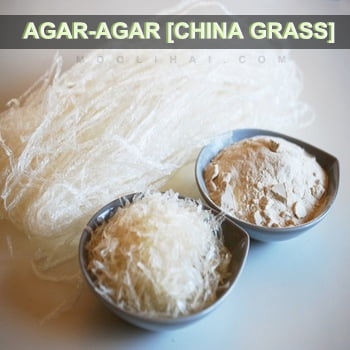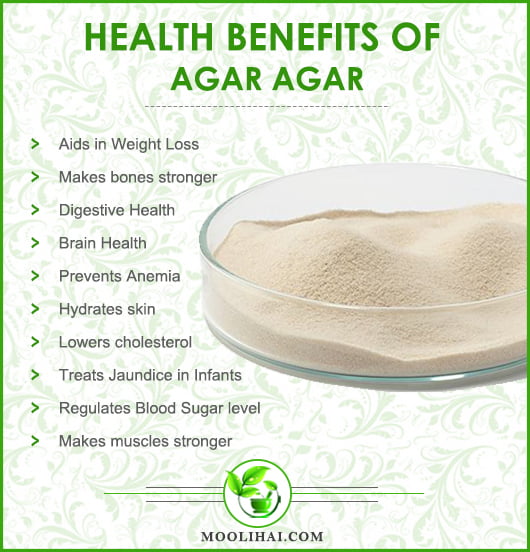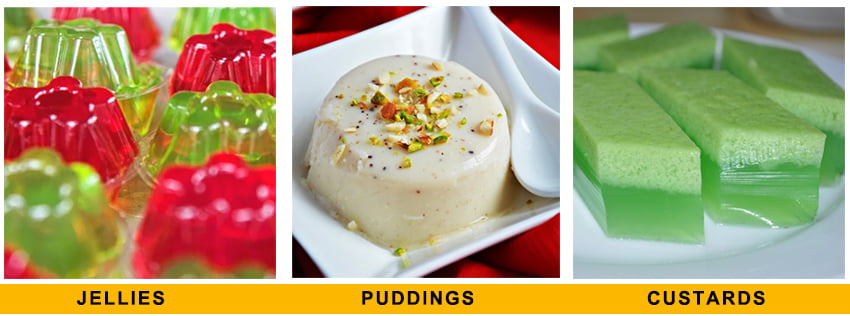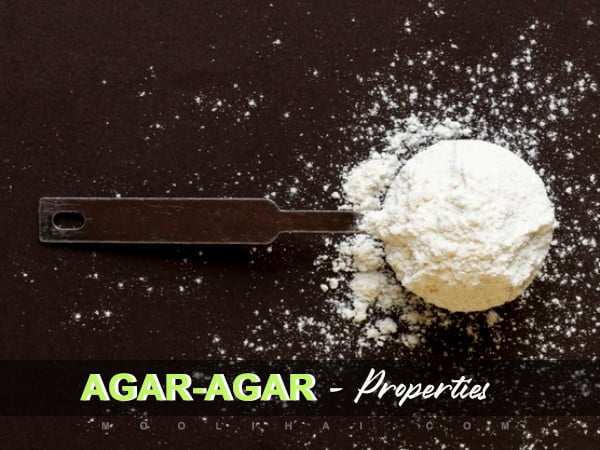Info
Health Benefits of Agar Agar [China Grass]
Agar-agar is obtained from red algae, which is a jelly-like substance. It is a mixture of two components polysaccharide agarose and a heterogeneous mixture of smaller molecules of agaropectin. Agar was initially discovered in Japan by Mino Tarozaemon accidentally. Agar-Agar is available in retail markets in the form of flakes, powder, strands, and bar products.
While cooking, agar-agar is used as an alternative for gelatin in a variety of dishes that includes pudding, jellies, mousses, ice creams, gummy candies, and cheesecakes. They are used for vegetarian preparation. Agar should be added to the recipe by dissolving it in water and then boil it.
It won’t get dissolved entirely until the water reaches a temperature of 90° C. This means the boiling of water is not necessary, but holding a temperature between 90° C – 100° C is really a challenging goal to maintain. So usually, it is said to boil the water until agar dissolves completely.
Common Names of Agar Agar
- Agarose
- Agarose Gel
- Agaropectin
- Agarweed
- Algue de Java
- Chinese Gelatin
- Colle du Japon
- Gelidium pacificum
- Gelidium vagum
- Gelosa
- Gelosae
- Gélose
- Japanese Isinglas
- Kanten Diet
- Kanten Jelly
- Garacilaria confervoides
- Gélatine de Chine
- Gelidiella acerosa
- Gelidium amanasii
- Gelidium cartilagineum
- Gelidium crinale
- Gelidium divaricatum
- Kanten Plan
- Layor Carang
- Mousse de Ceylan
- Mousse de Jaffna
- Qion Zhi
- Seaweed Gelatin
- Vegetable Gelatin
- Vegetarian Gelatin

What is Agar-Agar?

Agar-Agar is a derived product of red algae, and is used as a substitute for gelatin. Gelatin is used as a significant industrial agent, and gelatin is extracted from the bones and skin of animals. So the product that contains gelatin is usually referred to as non-Vegan. Since agar is extracted from algae and it has properties similar to gelatin. It is substituted in place of gelatin as a vegan component. In Japan, agar plants are called “kanten,” and people used them to make medicine. Agar is used for obesity, diabetes, constipation, neonatal jaundice, and some other conditions, but there are researches well enough to show the evidence and support these claims. Dental impressions can also be made with agar in dentistry.
History of Agar-Agar
Initially, In 1658, Agar-agar was discovered in Japan by Mino Tarōzaemon. He is an innkeeper in the current Fushimi-Ku. He has discarded excess seaweed soup and found out that it gets gel consistency after a winter night. At that time, agar is a common gelling agent which is used widely in Southeast Asian cuisines.
French chemist Anselme PayenAgar was the first person who did a chemical analysis on China grass (algae Gelidium corneum) in 1859. At the end of the 19th century, Agar-agar was a reliable medium for growing various microorganisms.
Agar replaced gelatin as the microbiological media’s base because of its higher melting temperature, which helps microbes to grow. Because of its versatility, agar production gets increased. Japan was the production center of Agar-agar until World War 2.
Constituents of Agar agar
Agar-Agar has a mixture of two polysaccharides, namely agarose and agaropectin. Agarose constitutes about 70% of agar, and is a linear polymer made of repeating subunits of agarobiose. Disaccharide(double sugar) is made up of D-galactose and 3,6-anhydro-L-galactopyranose.
China grass is an excellent source of fiber, calcium, iron, folate, and manganese. And it contains few amounts of calories, saturated fat, and cholesterol. Further, it does not contain sugar or carbohydrates, and so it aids in weight loss.
Agar is indigestible, but intestinal bacteria can ferment it the absorbable nutrients, especially short-chain fatty acids. And therefore, it gives two kilocalories per gram of agar.
Nutritional Fact for 100 Gram of Agar Agar
- Calories: 26
- Total Fat: 0 g
- Saturated fat: 0 g
- Polyunsaturated fat: 0 g
- Monounsaturated fat: 0 g
- Cholesterol: 0 mg
- Sodium: 9 mg
- Potassium: 226 mg
- Total Carbohydrate: 7 g
- Dietary fiber: 0.5 g
- Sugar: 0.3 g
- Protein: 0.5 g
- Calcium: 5%
- Iron: 10%
- Cobalamin: 0%
- Magnesium: 16%
IMPRESSIVE HEALTH BENEFITS OF AGAR-AGAR

Aids in Weight Loss
Agar-Agar is low in calories, sugar, fat, and carbohydrates, and therefore, it is a healthy food that can aid in weight loss plans. It will reduce hunger and thus help in weight loss. Agar-Agar is called as a hydrophilic colloid that is made up of water-soluble and indigestible fiber. Agar usually absorbs water, which provides your stomach to feel fullness and very low calories that helps people in decreasing their food intake.
Beneath that, when China grass passes through the body, it absorbs the glucose content present in the stomach and the digestive system, thus preventing the storage of glucose as fat. If not, Excess glucose produced during the breakdown of carbohydrates gets stored in the liver as glycogen. Sometimes this glucose, with the use of insulin, gets converted into fatty acids, which are later circulated to other body parts and stored as fat. These may be the reason for weight gain.
In Japan, people used to intake Agar Agar, which plays a significant role in a natural weight loss plan called the Kanten Diet.
How Japanese consume Agar Agar:
They prepare tea or hot water by adding a teaspoon of agar agar powder and consume it before meals. Apart from enhancing the feeling of food satisfaction, it also helps to regulate the blood glucose levels and prevents accumulation of fat. China grass is present in the daily diet of many Japanese women.
Digestive Health
Agar-Agar is enriched with fiber content that helps in maintaining the health of the digestive system. It improves the system by absorbing the toxic substances due to the undigested food (Ama) present in the gut and the gastrointestinal tract. And it eliminates the toxic waste safely from the body.
It is also considered as the best home remedy for constipation problems. The laxative property China grass has a soluble fiber that absorbs water present in the gut area and forms bulk. This will act as a laxative. Cleaning the bowel is essential in maintaining the health of the digestive system.
Research in 2012 says that consuming dietary fiber-rich Agar Agar increases the stool frequency in people with constipation issues. Constipation is a significant health problem that is faced by 20% of the world’s population. This issue will affect the quality of life and also increase the chance of colon cancer. Consuming dietary fiber-rich Agar-Agar can increase stool frequency in people facing constipation problems.
Another study says that increasing fiber intake could prevent you from gastrointestinal disorders, hemorrhoids, intestinal ulcers, diverticulitis, and acid reflux symptoms.
Bone Health
Regular intake of Agar Agar will increase the bone density because it has a high amount of calcium and magnesium. Calcium shows a significant contribution to the development and strength of bones. Yet, magnesium and calcium should be in balance to increase the density of the bone.
Most people think that calcium is enough to increase the strength of the bone. But too much of calcium may cause issues such as calcification of joints and the formation of kidney stones and gallstones.
Here, Agar-Agar has a balanced amount of these two minerals, which aids in the metabolism and formation of bones. Apart from magnesium and calcium, it also has vitamin D, C, and K, and potassium which are useful for healthy bones. For olden age people, osteopenia and osteoporosis problems become common, which leads to bone density loss. And untreated issues will increase the risk of fractures.
Brain Health
Agar-Agar is a polymer substance that consists of large macromolecules, which are made up of subunits. This unit has a simple sugar molecule galactose, which is also known as brain sugar. Galactose is vital for the development of the brain in infants and children. Therefore providing galactose-rich supplement foods like Agar, children will improve brain development.
When galactose gets processed by the human body, it forms glycolipids and glycoproteins in several tissues. Further, it is also crucial for the myelin sheath (efficient impulse transmission in the nerve), which protects the brain, spinal cord, and the central nervous system. If the myelin layer is damaged, then it will lead to neurological problems.
A recent study has claimed that galactose plays a vital role in eliminating neurotoxic compounds from the brain of Alzheimer’s disease-affected patients.
Prevents Anemia
Anemia is a severe issue that should be treated immediately. If not treated, it will lead to other severe health issues. It is a condition in which your body does not have sufficient healthy red blood cells (RBC). It will result in symptoms such as fatigue, dizziness, irregular heartbeat, and shortness of breath. The heart of an anemic patient will pump more blood because of low oxygen level in blood. This leads to heart failure.
Anemia may be due to the deficiency of the essential nutrient Iron. Here, consuming just one ounce of agar will provide a massive amount (33 %) of iron required for the entire day. Further, it can enhance the production of healthy red blood cells and thus minimize the risk of anemia. But, consuming agar along with other iron-rich and vitamin C-rich fruits or vegetables will improve the absorption of iron.
Regulates Blood Sugar level
Agar-agar is enriched with fiber; just 28 grams (1ounce) of agar is suggested to add in your daily diet to get enough amount of fiber to your body. Fiber slows down the absorption of glucose in the blood, thus helps in maintaining the blood sugar stable. It aids in preventing sudden ups and downs in the glucose level.
Studies based on the effect of china grass in regulating blood sugar had shown mixed results. Consuming food containing agar gel for 12 weeks (Japanese diet) has not enhanced the pre-meal blood glucose levels or insulin resistance in people with type 2 diabetes. Further, More research is required to determine the benefits of Agar-agar in regulating blood sugar.
Treats Jaundice in Infants
Jaundice is due to the high levels of a chemical known as bilirubin found in the blood. Sometimes newborns get affected by jaundice, and it is complicated to treat. Research suggests that providing Agar-agar to the infected infants for five days will not lower the bilirubin levels. But, when giving china grass along with light therapy, it will increase the bilirubin-lowering effects with lower light therapy duration.
Other Worldwide Uses of China Grass

Agar-agar is a natural vegetable gelatin substance that is white and semi-transparent. And it is sold in packages as washed and dried strips or powder. It is used in the process of making jellies, puddings, and custards.
- While preparing jelly, Agar-agar is boiled in water until it gets dissolved. Further, sweeteners, flavoring agents, coloring substances, fruits, or vegetables can be added. The prepared liquid is then poured into molds to get the shape and then leave it to settle for a few hours. You can then serve it as a dessert or combine it with other desserts ( maybe as a jelly layer in a cake).
- Anmitsu is a Japanese cuisine in which a dessert made of little cubes of china grass jelly is served in a bowl with various fruits.
- Agar is also used in the preparation of mizu yokan, which is another popular Japanese food.
- In Philippine dishes, Agar is used to prepare jelly bars and desserts such as sago gulaman, buko pandan, halo-halo, agar flan, and the black and red gulaman, which is used in many fruit salads.
- In Vietnamese cuisine, jellies are prepared with flavored Agar-agar layers, and a famous dessert is made with ornate molds for special occasions.
- In Indian cuisine, Agar-agar is also known as China grass which is used in making pudding and desserts.
- In Burmese cuisine, kyauk kyaw (sweet jelly) is prepared from Agar.
- In Taiwan, Agar jelly is used in bubble tea.
- In Russia, it is used as an alternative for pectin in jams.
- In Mexico, traditional candies called Dulce de Agar are prepared with Agar Weed. It is a colorful, half-circle shape that looks like a watermelon slice, and is covered with sugar.
Making Process of Agar Agar
Agar-Agar is extracted from seaweed and processed into flakes, sheets, and powder based on the needs. Simplifying the steps, there are five necessary steps for obtaining Agar from seaweed:
- Cleaning the seaweed
- Chemical pretreatment of seaweed
- Extraction of seaweed
- Filtration
- Bleaching and dewatering of gel
The seaweed is washed with water at room temperature, as the Agar is insoluble at room temperature, and the water washes away the impurities. Then alkali pretreatment is carried out to obtain the product at higher gel strength. Using hot water, Agar is extracted from seaweed. This extraction is carried out in the vessel, and on completion, the hot aqueous extract is allowed to drain at the bottom of the vessel. Then the obtained gel is cooled at 10° C to 20° C, and then Agar is allowed to thaw, then washed with water and bleached by immersing it in a tank with hypochlorite solution for 10 -15 minutes. Agar is washed several times and finally it is put on mesh screens to dry.
Difference Between Agar-Agar and Gelatin

The main difference between china grass and gelatin is, using which they are produced or harvested.
- Agar-agar is manufactured from red algae plants, and it is 100% Vegetarian. But Gelatins are animal-based products that are manufactured from the cartilages, tissues, ligaments, bones, skin, and tendons of cows and pigs and therefore it is Non-vegetarian.
- These substances act differently, and therefore you need to prepare them in different ways. Agar-agar is cooked at the temperature of 185 F, while gelatin can be prepared by simply dissolving it in warm water because gelatin melts at 95 F.
- The jelly consistency of Agar-Agar sets quickly, but gelatin needs to set or cool with the help of a refrigerator.
- When exposed to higher temperatures, Agar-agar recipes stay normal (solid), but gelatin loses its consistency.
- Cuisines or dessert prepared with agar will be stable and less creamy when compared to the dish made with gelatin.
Advantages of Agar-Agar over gelatin
There is no significant taste, color, and odor for Agar. Unlike gelatin Agar is more firm and stays firm even when heated up. It is also said that the cost of Agar is higher than gelatin, but 1 part of agar powder can be a substitute for eight parts of gelatin. So comparatively, Agar is cost-efficient too.
Varieties of Agar-Agar available in Market
You can purchase Agar-agar as powder, flakes, bars, and strands. The china grass seaweed is boiled to form a gel, then pressed, dried, and processed to produce various forms of Agar-agar.
- Agar powder – Dried Agar is grinded into a powder. The powder form is less expensive than flakes, and you can easily prepare a variety of dishes by just dissolving it instantly. Use a 1:1 ratio of agar powder while adding it as a substitute for gelatin.
- Agar flakes – Dried Agar is coarsely crushed to produce agar flakes. Agar flakes need a few more minutes to blend with water or milk to get a smooth consistency. While using flakes, add 1/3 of the amount of gelatin.
- Agar bars – Dried Agar is freeze-dried to produce bars.
- Agar strands
Like gelatin, flavored and colored agar are also available in the market.
Properties of Agar-agar / China Grass

The gelling properties of Agar-agar are useful in multiple applications. The most important characteristics of Agar weed are listed below.
- The main property of Agar-agar is its solubility. It remains insoluble in cold and soluble in hot water.
- When boiled with water, agar becomes a liquid at the melting temperature of 85-95 °C (185-203 °F), and when cooled, it forms a gel-like substance at 32-40 °C (86-104 °F). This property makes Agar unique from other gelling agents.
- It has an excellent gelling power when contact with a watery substance, and it allows to form gels that are solid than other gel-forming agents, even when using other agents in the same concentrations.
- The simple water solution is enough to get solid gel consistency. There is no need to add reagents such as potassium or calcium to produce gelation.
- High sugar concentrations or an acid environment are also not required.
- Agar-agar can be used with a wide range of pH, from 5 to 8.
- It is able to tolerate thermal treatment conditions above 100°C and therefore, it provides satisfactory sterilization.
- Agar weed is used in gel food products without any flavor, and it also does not require the addition of cations (potassium or calcium) with intense flavors.
- Agar matches and improves the flavors of products mixed with it.
- Agar gel is stable and does not form precipitates.
- Agar-agar gel has an extraordinary reversibility property which allows it to be gelled and melted, again and again without losing its original properties.
- Agar is a transparent substance that can be colored easily. The refractive index of agar can also be enhanced by adding sugar, glucose, or glycerine to give attractive brightness.
Possible Side Effects of Agar Agar
It is safe for most adults, when consumed agar with a minimum of an 8-ounce glass of water. When ignoring the above fact, Agar can swell and block the esophagus or bowel. Consulting a physician or doctor is necessary if there is a difficulty in swallowing or breathing, chest pain, and vomiting after eating Agar.
- Agar is safe for children with neonatal jaundice when fed to them via mouth for seven days.
- The information about consuming Agar-agar during pregnancy and breastfeeding is not available from any reliable resource. So it is good to stay on the safer side by avoiding Agar during pregnancy and breast-feeding.
- As discussed earlier, Agar-agar can make obstruction in the bowel and becomes difficult when it is not consumed with enough water or any other liquid. So guidance from the doctor is recommended when you have a bowel obstruction.
- Sometimes, Agar may swell up and block the esophagus if not eaten with a sufficient amount of water or other liquids. So, better take proper medical advice before consuming Agar-agar.
- It may also increase the growth or development of colon cancer tumors. So discuss with your medicinal advisor before consuming Agar if you are at risk for colon cancer.
Conclusion
Agar-agar is a non synthetic agent which can be used as a thickener, gelling agent, moisturizer, flavor enhancer, and absorbent in foods based on your need. People use it for its weight-losing property.



Ponnatharam Stone (Raw) | For Permanent Hair Removal
Vengai Paal | Black Bindi | Dhrishti Pottu | Vengai Pottu for Babies | 100% Natural
Dried Avaram Senna Flower / Cassia Senna Auriculata / Aavaram Poo / Tarwar / Amaltas Leaves / Senna Auriculata / Avaram Poo / Sanay / Alexandrina / Tanner’s Cassia flower
Natural Dried Moringa Flower – Moringa Oleifera – Drumstick Tree Flower – Murungai Poo – Munagaku Flower
Akasa Garudan Kilangu / Redfruit Creeper / Corallocarpus Epigaeus
Original Edible Camphor | Pacha Karpooram | Bhimseni Camphor
Saussurea Obvallata Seeds / Brahmakamal Seeds / Queen of the night / Sacred Saussurea Kon Kapfu / Brahma Kamalam / Nishagandha
Insulin Leaf Powder / Chamaecostus Cuspidatus / Costus Pictus / Spiral Ginger / Insulin Powder / Costus Igneus
Achu Pottu for Babies | Bindi Mould Set | Baby Seratta – 1 Set
Kaunch Beej Powder |Poonaikali | Velvet Bean Powder | Mucuna Pruriens | Kapikacchu | Natural Nervine Tonic & Muscle Builder
Aalam Pazham / Banyan Fruit Powder / Ficus Benghalensis / Marri Palu / Bargad / Dodda Alada Mara / Peraal / Vat Vriksha Powder
Traditional Vasambu Valayal for Babies | Calamus Bracelet | 100 % Pure & Natural